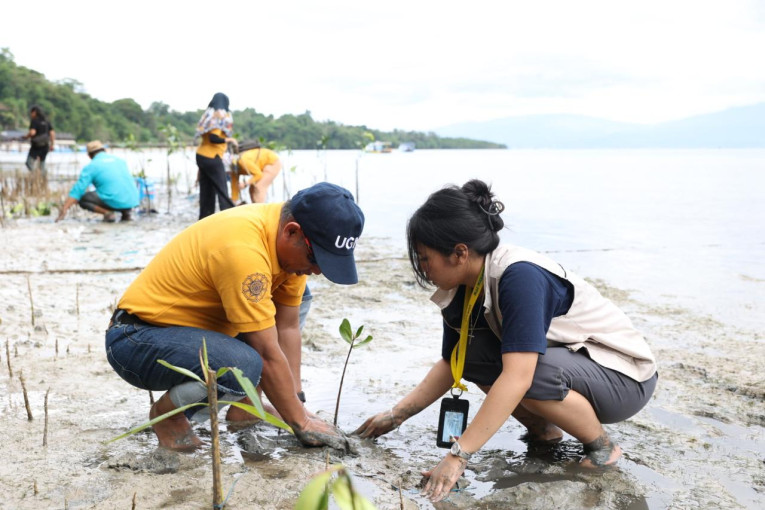
A team of UGM KKN-PPM students carried out activities involving the release of 80 turtle hatchlings and planting 150 mangrove seedlings to support marine tourism on Bunaken Island, Manado, North Sulawesi Province.
The release of the hatchlings and the mangrove planting were conducted by KKN-PPM students along with the University Secretary, Dr. Andi Sandi, the Director of Community Service, Dr. Rustamaji, and the Bunaken National Park team on Friday (Aug. 9) on Bunaken Island.
Dr. Andi Sandi, who participated in the mangrove planting, expressed hope that the mangroves could help protect against ocean waves and prevent coastal erosion.
“There are several planting sites that students, together with the National Park Office, will work on until mid-August,” he said.
According to Dr. Andi Sandi, the students’ KKN activities support marine tourism on Bunaken Island and help preserve marine biodiversity. The presence of mangrove forests and coral reef conservation can support snorkeling and diving spots in Bunaken.
“We aim to protect biodiversity while also preserving the livelihoods of the local community, maintaining resources, and securing their means of living,” he stated.
The Director of Community Service, Dr. Rustamaji, emphasized that the mangrove conservation activities are part of efforts to protect the environment in the face of climate change threats.
“Climate change can threaten small islands, in addition to causing erosion,” he noted.
In response to journalists’ questions, Dr. Rustamaji mentioned that mangrove seedling planting is also being conducted in other KKN locations, such as Batam and Kupang.
“About 30 percent of KKN activities occur in coastal areas,” he said.
The Head of Bunaken National Park, Faat Rudhianto, explained that the mangrove planting and turtle release programs, conducted in collaboration with KKN students, are part of ongoing conservation efforts in the area.
He noted that the National Park routinely conducts patrols for turtle eggs, which are then semi-naturally hatched to protect them from predators if left in their nests.
“The eggs must be secured and hatched semi-naturally, then raised until they can be released,” he said.
Additionally, mangrove planting is necessary due to the open areas along Bunaken Island’s coastline, which are caused by the reduction of mangrove forests.
“In coastal areas starting to become exposed, ecosystem restoration is needed so that sea waves do not erode the beaches,” he explained.
Rudhianto welcomed the involvement of KKN-PPM students on Bunaken Island, noting that many of their work programs support forest and coral reef conservation in the national park.
“From the beginning, they have been engaged in conservation through promotion and concrete action,” Rudhianto said.
Bunaken team coordinator Prasetio Utomo mentioned that the turtle release and mangrove planting activities are part of the 127 work programs they are implementing on Bunaken Island.
“These activities are our efforts to support conservation to enhance marine tourism on Bunaken Island,” he said.
In addition to mangrove planting and turtle conservation, the student team collaborates with the Bunaken National Park to conduct coral transplantation activities. They also empower residents to process food resources like bananas, breadfruit, and fish into tourist souvenirs.
“We are encouraging fish processing into floss and making banana and breadfruit chips as Bunaken specialties,” he added.
Author: Gusti Grehenson
Photographer: Firsto

